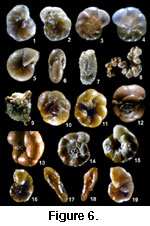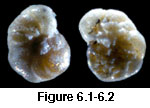 Genus DISCORINOPSIS Cole, 1941
Genus DISCORINOPSIS Cole, 1941
Figure 6.
 Genus DISCORINOPSIS Cole, 1941
Genus DISCORINOPSIS Cole, 1941
Figure 6.
Discorinopsis aguayoi (Bermudez), 1935
Figure 6.1 and 6.2
v. 1935 Discorbis aguayoi Bermudez, 1935, p. 204, pl. 15, figs. 10-14.
v. 1953 Discorinopsis aguayoi (Bermudez). Phleger, Parker, and Peirson, 1953, p. 7, pl. 4, figs. 23, 24. Scott et al. 1990, p. 730, pl. 1, figs. 6a, b.
v. 1963 Trichohyalus aguayoi (Bermudez). Bermudez and Seiglie, 1963, p. 176, pl. 26, fig. 4
 v. 1954 Discorinopsis aguayoi (Bermudez). Arnold, 1954, p. 6-12, pl.1, figs. 1-10.
Bock, 1971, p. 50, pl. 18, fig. 42.
Steinker, 1980, p. 135, pl. 2, fig. 6.
v. 1954 Discorinopsis aguayoi (Bermudez). Arnold, 1954, p. 6-12, pl.1, figs. 1-10.
Bock, 1971, p. 50, pl. 18, fig. 42.
Steinker, 1980, p. 135, pl. 2, fig. 6.
This species is highly variable in test perforation, test shape, and amount of spongy material on the ventral side (Javaux 1999). This variability has been shown before only in cultured specimens (Arnold 1954).
This species is one of the characteristic species of mangrove assemblage in Bermuda, and also lives in Bermuda landlocked marine ponds fringed by mangroves. It occurs in mangroves of Florida-Bahamas and Columbia, and in Equator and Brazil (where it is called D. vadescens). It is reported in nearshore and lagoons of Florida-Bahamas and in brackish-water of Belize Shelf, probably coming from nearby mangrove areas.